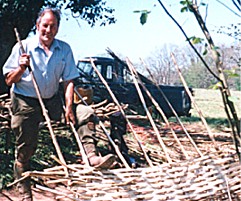One of the oldest country crafts is that of the hurdlemaker. From the time man first separated his livestock, or wanted demarcation from his neighbour, hurdles have been used. Some of the oldest in wattle and daub walls have survived for centuries. The earliest known hurdle ever found was in the Somerset Levels and is estimated to be 5,000 years old. Made in hazel and willow it was used flat as a walkway, and the peat preserved it all that time. Interestingly, hazel hurdles were often used to shore up trenches in both World Wars. Traces of hurdles have been found in Iron Age excavations and Romans often used them during their years of occupation.
During the 19th century the use of wattle hurdles was widespread for folding sheep and a large number of men were employed making them. Most Dorset villages had their own hurdlemaker and in 1885 eleven were recorded as working in Wool alone. Inevitably, modern methods such as electric fencing and wire mesh, meant a decline in the demand for sheep hurdles and only a few craftsmen persevered with the trade and made hurdles for gardens rather than sheep.
Between 1950/60 the demand for hazel was reduced in proportion to the decline in hurdle making and spar making for thatching ricks and cottages. Many old thatched dwellings used by agricultural workers had fallen down or were being demolished, and ricks were being covered in plastic sheeting. For many years the thatcher took pride in waterproofing haystacks for the long winter months. It followed that landowners were turning the under-used hazel copses into forestry plantations, but some copses survived and were put into the care of a hurdle-maker to maintain them.

The wood is generally coppiced on a seven-year rotation and a hurdle maker needs roughly four acres a year, depending on the density of the wood. At this age it will yield all the different sizes of wood needed. Landowners recognise the value of coppicing more and more as time goes by, although some smaller copses are spoilt by deer browsing on the very young shoots, causing stunted growth and forked wood. Damage is also caused by bad cutting. It should be cut in an upward sloping cut which leaves the butt about three or four inches high with a clean surface which allows the water to run off.

